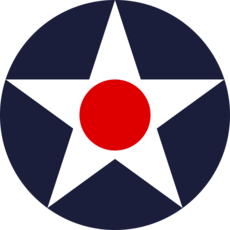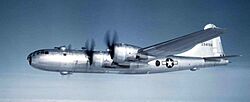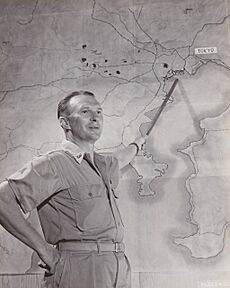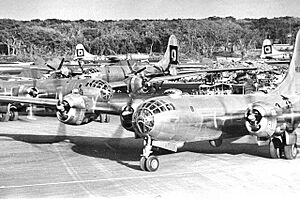Haywood S. Hansell facts for kids
Quick facts for kids
Haywood S. Hansell
|
|
|---|---|
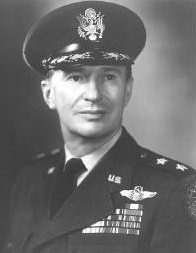
Hansell, c. 1951
|
|
| Nickname(s) | Possum |
| Born | September 28, 1903 Fort Monroe, Virginia |
| Died | November 14, 1988 (aged 85) Hilton Head, South Carolina |
| Buried |
United States Air Force Academy Cemetery
|
| Allegiance | |
| Service/ |
|
| Years of service | 1928–1946 1951–1955 |
| Rank | |
| Commands held | 3rd Bombardment Wing 1st Bombardment Wing XXI Bomber Command |
| Battles/wars | World War II |
| Awards | Distinguished Service Medal Silver Star Legion of Merit Distinguished Flying Cross Air Medal |
Haywood Shepherd Hansell Jr. (born September 28, 1903 – died November 14, 1988) was an important American general officer in the United States Army Air Forces during World War II. He later served in the United States Air Force. He strongly believed in using strategic bombing, which means attacking an enemy's ability to make war, like factories or oil fields. He was a main designer of daylight precision bombing, a plan for American airpower during the war. This meant bombing specific targets during the day to be more accurate.
Hansell played a very important, though often unmentioned, role in planning air operations for the United States. He helped create the main air war plans for the U.S. and the plan for bombing Europe. He also helped set up bases for the powerful B-29 Superfortress bombers in the Mariana Islands. He designed the command structure for the Twentieth Air Force, which was the first global air force. Hansell believed that accurate air attacks were the best way to win battles and were also more humane. However, his bombing campaign over Japan faced problems like strong winds (jet streams). He was replaced by General Curtis LeMay, who changed tactics to destructive nighttime area bombing (firebombing) of Japanese cities.
Hansell also led combat units during the war, putting his own plans into action. He was a pioneer in strategic bombing against both Germany and Japan. He commanded the first B-17 Flying Fortress combat wing in Europe and was the first leader of the B-29 force in the Marianas.
Contents
Early Life and Family
Hansell was born in Fort Monroe, Virginia, on September 28, 1903. His father, Haywood S. Hansell, was an Army surgeon who later became a colonel. His mother, Susan Watts Hansell, came from a well-known family in Georgia. His family had a long history of military service, with relatives fighting in the American Revolution and the War of 1812.
When he was very young, his family lived in Beijing, China, and then in the Philippines. Because of this, Hansell learned to speak both Chinese and Spanish early in life. In 1913, his father was stationed in Georgia, and then at Fort Benning. His father was very strict. He sent Hansell to live on a family ranch in New Mexico because he felt Hansell wasn't disciplined enough in school. There, Hansell learned to ride horses, shoot, and studied with a private teacher.
School Days
In 1916, Hansell went to Sewanee Military Academy in Tennessee. This is where he got his lifelong nickname, "Possum." People think he got this name because his face looked a bit like a possum. At Sewanee, he really enjoyed English literature. In his final year, Hansell became a cadet captain. He was known for being very strict with other cadets. However, he got into trouble himself and was demoted to a cadet private.
Because of this, Hansell decided not to go to the United States Military Academy. Instead, he attended the Georgia School of Technology. He struggled with advanced math but eventually mastered it. In 1924, he graduated with a degree in mechanical engineering. While at Georgia Tech, he played varsity football and also boxed. He was recognized with the ANAK Society, a high honor at the school.
From 1924 to 1928, Hansell tried to find work as a civil engineer in California, where his father was stationed. He didn't find a job in engineering. Instead, he worked as an apprentice and then a skilled worker (journeyman) making boilers for a company. In the 1920s, aviation (flying) was advancing quickly. Hansell decided he wanted a career in designing aircraft. To learn to fly, he joined the United States Army Air Corps.
Personality and Family Life
Hansell was short and slender, but he worked hard to be an athlete. He was good at tennis, polo, and squash. Socially, he was a great dancer. He was also known as "the unofficial poet of the Air Corps" because he loved poetry. He enjoyed the works of Gilbert and Sullivan, Shakespeare, and Miguel de Cervantes' Don Quixote.
General Ira C. Eaker said Hansell was "nervous and high strung." Some people noted he could be bossy in social situations. However, his secretary during World War II described him as "pleasant and diplomatic." An aviation historian called him "a forward-looking optimist with a sense of humor."
While stationed in Virginia, Hansell met Dorothy "Dotta" Rogers, a teacher. They married in 1932. They had three children: Tony (born 1933), Lucia (born 1940), and Dennett (born 1941). Hansell's long work hours and frequent trips during World War II put a lot of stress on their marriage. However, they stayed married for 56 years until his death in 1988. Hansell's oldest son, Tony, also joined the military. He became a colonel in the Air Force.
Early Air Force Career
Becoming a Pilot
On February 23, 1928, Hansell became a flying cadet. He completed his basic flight training in California. Then, he had advanced training in flying pursuit planes in Texas. He finished pilot training on February 28, 1929. He became a second lieutenant in the Army Reserve. He officially joined the Air Corps as a second lieutenant on May 2, 1929.
Hansell's first job was with the 2nd Bombardment Group in Virginia. There, he tested repaired aircraft. In 1931, he had to use a parachute to escape from his Boeing P-12 plane when it stalled during a test flight. He was blamed for the accident, but the cost of the plane was eventually dropped.
In 1931, Hansell moved to Maxwell Field, Alabama. He became an assistant operations officer. He also flew with the 54th School Squadron. There, he met Captain Claire L. Chennault, an instructor. Hansell joined their aerobatic team, "The Men on the Flying Trapeze." He also worked with Captain Harold L. George, who led the bomber section at the Tactical School. This is when Hansell's interest changed from fighter planes to bombers. George became Hansell's mentor and supporter.
Belief in Strategic Airpower
Hansell was promoted to first lieutenant on October 1, 1934. He then became a student at the Air Corps Tactical School at Maxwell Field. This was a long course that taught about air tactics and airpower theory. It also covered other military services, combined warfare, weapons, and navigation. Captain George, now a director, was one of his instructors. George's classes were very interactive, with lots of discussions and debates.
Hansell was one of the youngest instructors in the school's history. He taught there from 1935 to 1938. He became part of a group called the "Bomber Mafia." These were instructors who strongly believed in daylight precision strategic bombardment. They also wanted the Air Force to be an independent military branch. Many of Hansell's students later became generals and supporters of strategic airpower during World War II.
In 1938, Hansell went to the Command and General Staff School in Kansas. He graduated in 1939, shortly after being promoted to captain. He then worked for General Henry H. Arnold in the Office, Chief of Air Corps. He helped Arnold build an Air Staff to plan the Air Corps' huge expansion.
Hansell became responsible for setting up intelligence operations for strategic air attacks. He created sections to analyze foreign air forces, airfields, and to choose targets. He also made contacts with Royal Air Force officers in Washington, D.C. to get more information. In July 1941, Hansell went to London, England, as an observer. He learned a lot about the RAF's intelligence and their target plans for German industry. He said the U.S. received a huge amount of information from this exchange.
Planning for World War II
The AWPD-1 Plan
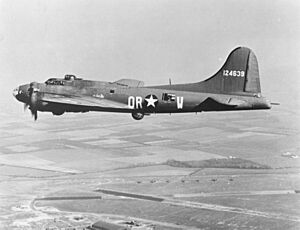
In July 1941, Hansell joined the Air War Plans Division (AWPD) in Washington, D.C. He was the Chief of the European Branch. There, he worked with other "bomber mafia" members to create a plan for President Franklin D. Roosevelt. This plan estimated how many aircraft and people would be needed to win a war against the Axis Powers.
Hansell's part of the plan, called AWPD–1, focused on information about German targets. The team completed the plan in just nine days. It accurately predicted the number of units and personnel needed for the war. It also correctly estimated when the Allied invasion of Europe would happen.
However, Hansell's part of the plan had a big mistake. He, like many others, thought that the Nazi economy was working at its maximum. But it was actually still at 1938 production levels. This led to underestimating how many bombing missions and bombs would be needed. A more serious mistake was not including long-range fighter escorts for the bombers. This greatly affected the strategic bombing campaign later on. Hansell regretted this omission. He noted that it was based on the best information available at the time, which suggested that adding range to fighters would make them less effective in combat.
War Planning Duties
After the United States entered World War II, Hansell was quickly promoted. He became a lieutenant colonel in January 1942, a colonel in March 1942, and a brigadier general in August 1942. In January 1942, he helped plan how the Air Corps would be organized within the Army during the war. This led to the creation of the Army Air Forces in March 1942. Hansell then became the USAAF representative on the Joint Strategy Committee.
In July 1942, Hansell was assigned to General Dwight D. Eisenhower's headquarters in Europe. He was also the deputy air officer for Major General Carl A. Spaatz, commander of the Eighth Air Force. His job was to influence Eisenhower's ideas on using airpower. He even flew a combat mission in a B-17 to experience daylight precision bombing firsthand. During this mission, he got frostbite on his hands.
In August 1942, he was called back to USAAF Headquarters to lead the team for AWPD–42. This was a revised air strategy plan. Even though the Navy rejected it, President Roosevelt unofficially followed its ideas. Hansell then returned to England.
Leading a Combat Wing in Europe
On December 5, 1942, Hansell received his first combat command: the 3rd Bombardment Wing. This unit was supposed to support the Eighth Air Force's heavy bombers. However, the wing had no planes or units yet. So, on January 2, 1943, Hansell was moved to command the 1st Bombardment Wing, which flew Boeing B-17 Flying Fortress bombers. Hansell flew his first mission with his new command the next day, bombing submarine pens in Saint-Nazaire, France. He saw how effective German fighter planes were, as both planes flying next to his were shot down. Later that month, on a mission to Lille, France, the pilot of his B-17 was killed, and the plane was almost shot down.
Hansell led the 1st Wing during six very important months. The B-17 force was new and struggled to prove itself. Hansell helped develop combat tactics, like using the defensive combat box formation. This formation helped bombers protect each other. He also made sure all planes bombed together with the lead bomber to improve accuracy.
Hansell realized the main problems with the idea of daylight precision bombing:
- Radar early warning systems and the lack of long-range escort fighters made deep bombing raids too costly.
- German industry was not fragile; it could recover and move production.
These factors later influenced his plans for bombing Japan.
On March 23, 1943, he led a committee to create a plan for the Combined Bomber Offensive (CBO). This plan changed the bombing priorities. It focused on destroying the German aircraft industry and the German Luftwaffe (air force). Hansell wrote the final version of the CBO plan himself. Even though Hansell didn't personally fly in later bombing operations against Germany, he was key in setting up the plans that led to the destruction of German war industry.
He continued to fly combat missions as often as his group commanders. His last mission was to Antwerp on May 4, 1943. On June 15, 1943, General Eaker noticed Hansell was tired and stressed. He replaced Hansell as commander of the 1st Wing. Hansell then became a staff officer, helping with air planning for the Allied forces. He also helped plan Operation Tidal Wave, a low-level bombing of oil refineries in Ploieşti, Romania.
Planning B-29 Operations
In October 1943, General Hansell became chief of a planning division at USAAF Headquarters. He immediately started planning strategic air attacks on Japan. The initial plan suggested that only an invasion could defeat Japan. But Hansell successfully argued that an invasion should only happen if bombing and a sea blockade failed to make Japan surrender.
Hansell traveled with President Roosevelt to the Sextant Conference in November. In December, he became Deputy Chief of the Air Staff, working directly with General Arnold. His main job was to develop the plans for the B-29 Superfortress bomber. He helped make three key decisions: B-29s would not be diverted to General Douglas MacArthur, bases for the B-29s would be secured in the Mariana Islands sooner, and the Twentieth Air Force would operate independently, reporting directly to the Joint Chiefs of Staff.
Hansell created the tactics and organization for the Twentieth Air Force. General Arnold himself would command it. When Arnold had a heart attack in May, Hansell acted as the unofficial commander of the Twentieth Air Force.
Leading B-29 Bombers
On August 28, 1944, Arnold made Hansell commander of the XXI Bomber Command. Some leaders worried that Hansell, while a great planner, wasn't suited to be a combat commander. Arnold promised not to remove Hansell quickly. However, Hansell's position was threatened from the start. His replacement on the Air Staff, Major General Lauris Norstad, didn't support daylight precision bombing. Instead, Norstad favored massive destruction of Japanese cities by firebombing. This tactic was gaining support among Air Force leaders, including Arnold. They wanted to defeat Japan quickly and felt the American public wanted revenge for the war. Hansell, however, thought firebombing was wrong and unnecessary.
XXI Bomber Command arrived on Saipan on October 12, 1944. Hansell immediately faced many serious problems. The B-29s still had technical issues, and planes were delivered late. Aircrews weren't trained for high-altitude formation flying. Airfields were basic, and there was no proper support for repairs. There was also a complete lack of intelligence about targets. His own combat wing resisted daylight operations. Some of his officers wanted him removed. Also, Hansell was outranked by other Air Force commanders in the area. He was soon forbidden from flying combat missions, possibly because he knew about the atomic bomb or secret intelligence (Ultra).
High-altitude daylight B-29 raids against Japanese aircraft factories began on November 24, 1944. These missions faced bad weather and strong jet stream winds. As a result, they didn't seem to be very effective. Arnold pressured Hansell for better results. Hansell made his command work harder, which caused more anger among his aircrews. At the same time, commanders in China wanted the XX Bomber Command moved. This made Major General Curtis E. LeMay, who now outranked Hansell, available for command.
On January 6, 1945, Norstad visited Hansell's headquarters and suddenly removed him from command. LeMay replaced him. Hansell was offered a different command, but he declined. While many problems led to his removal, the main reasons were Hansell's insistence on daylight precision attacks and his reluctance to use night firebombing. Norstad felt Hansell was blocking the use of incendiary attacks. Arnold and Norstad also thought Hansell's public relations efforts were poor.
Hansell left Guam on January 21, 1945. Unknown at the time, his precision daylight attacks had actually succeeded. They forced Japan to spread out its aircraft engine industry. His final raid also caused significant destruction. A more immediate success of his command was creating an effective air-sea rescue system with the U.S. Navy. This system saved half of all B-29 crews who went down at sea in 1945.
Impact on Air Strategy
Hansell believed in a different strategy to defeat Japan using precision bombing. He thought it would have worked by November 1945 without needing area bombing with incendiaries or the atomic bomb. He didn't think the incendiary strategy was wrong in itself. However, he disagreed with the idea that firebombing was necessary because Japan couldn't be defeated otherwise.
Historian Dr. Charles Griffith believes Hansell sacrificed his command and later career for his principles. He stuck to the idea that precision bombing was more moral and effective than area bombing. Griffith argues that Hansell's dismissal was a key moment in U.S. airpower. It pushed the Air Force towards bombing civilian populations. This led to a greater reliance on the devastating idea of nuclear warfare for decades.
Conrad Crane, another historian, had a slightly different view. He argued that despite the firebombing in Japan, American air commanders still focused on precision bombing and avoiding civilian deaths. He said that the use of precision guided weapons in later wars showed a continued commitment to precision bombing. This showed progress towards the ideal that Hansell and other early airpower thinkers first imagined.
Hansell lectured about precision air attack throughout his life. He often spoke at the United States Air Force Academy and the Air War College. He wrote three books about air strategy. He also continued to study modern weapons. He supported the Strategic Defense Initiative and the B-2 Spirit bomber. His main goal was to promote technical advances in precision guided weapons. He wanted to make precision bombing more practical and therefore a more desirable military strategy.
Later Life and Retirement
After being removed from command in Guam, Hansell asked for a B-29 training assignment. On February 15, 1945, he took command of the 38th Flying Training Wing in Arizona. In June 1945, he moved to Air Transport Command. He commanded the Caribbean Wing in West Palm Beach, Florida, and then the North Atlantic Wing in Westover Field, Massachusetts.
Hansell retired early on December 31, 1946, due to hearing loss. He retired with the rank of brigadier general. He worked as vice president of Peruvian International Airlines until 1949. He then became vice president of South Atlantic Gas Company until he was called back to the military.
He was called back to active duty on July 15, 1951, by Air Force Chief of Staff Hoyt S. Vandenberg. He became Chief of the Military Assistance Program Headquarters, USAF. He was a senior program manager and advisor to the U.S. Joint Chiefs of Staff. On September 5, 1952, he was promoted to major general. In April 1953, Hansell became the senior Air Force representative to a group that evaluated weapon systems. He retired a second time from the USAF in 1955.
Hansell then worked for General Electric. He became the head of its subsidiary in the Netherlands until 1967. He then retired to Hilton Head, South Carolina. He passed away on November 14, 1988, in Hilton Head, from heart failure. He was buried with full military honors at the United States Air Force Academy Cemetery.
Awards and Decorations
Hansell received many awards and decorations, including:
 |
||
 |
||
| U.S. Air Force Command Pilot Badge | ||
| USAAF Technical Observer Badge | ||
| Army Distinguished Service Medal | Silver Star | Legion of Merit |
| Distinguished Flying Cross | Air Medal | Army Commendation Medal |
| American Defense Service Medal | American Campaign Medal | Asiatic-Pacific Campaign Medal with bronze campaign star |
| European-African-Middle Eastern Campaign Medal with bronze campaign star |
World War II Victory Medal | National Defense Service Medal |
| Air Force Longevity Service Award with four bronze oak leaf clusters |
Honorary Commander of the Order of the British Empire (United Kingdom) |
Order of Merit of the Italian Republic degree unknown (Italy) |


